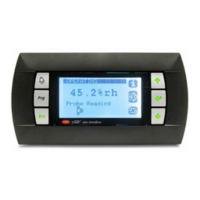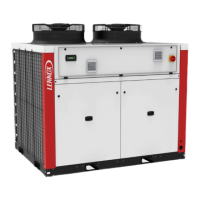Installation - Operation - Maintenance manual (IOM) • AIR COOLED CHILLERS & SPLIT UNITS - 0105-E • 31 •
MAINTENANCE
7. MAINTENANCE
The following maintenance instructions form a part of the operations required for this type of equipment.
However, It is not possible to give fixed and precise rules for permanent maintenance procedures capable of
keeping all units in perfect operating condition since too many factors depending on local conditions specific to the
installation, the way the machine is operated, the frequency of operation, climatic conditions, atmospheric pollution,
etc. Only trained experienced personnel can establish strict maintenance procedures adapted to the conditions
listed above.
Nonetheless, we recommend a regular maintenance schedule :
- 4 times a year for chillers operating all year long
- 2 times a year for chiller that only operate during the cooling season
All operations must be performed in conformity with the maintenance plan; this will extend the service life of the unit
and reduce the number of serious and costly breakdowns.
It is essential to keep a «service log», for weekly records of operating conditions of the machine. This log will serve
as an excellent diagnostic tool for maintenance personnel ; likewise, the machine operator, by noting down changes
in machine operating conditions, will often be able to anticipate and avoid problems before they actually occur or
worsen.
The manufacturer cannot be held responsible for any malfunctioning of any equipment it provides if it is
caused by a lack of maintenance or by operating conditions beyond those recommended in this manual.
Shown below, and as an illustration only, are some of the most common rules applied for maintenance.
7.1 WEEKLY MAINTENANCE
1) Check the compressor oil level. This should be half way up the sightglass with the machine running at full load.
Let the compressor operate for 3 to 4 heures before adding any oil. Check the oil level every 30 minutes. If the
level does not reach the level indicated above, contact a qualified refrigeration mechanic.
2) Overcharging with oil can be as dangerous to a compressor as a lack of oil. Before topping up, contact a qualified
technician. Only use oils recommended by the manufacturer. See page 15.
3) Check the oil pressure.
4) The flow of liquid refrigerant through the sightglass should be steady and without bubbles. Bubbles are a sign
of a low charge, a possible leak, or of a restriction in the liquid line. Contact a qualified technician.
Each sightglass is fitted with a humidity indicator. The colour of the element changes according to the level of
humidity in the refrigerant, but also according to temperature. It should indicate «dry refrigerant. If it shows «wet»
or «CAUTION», contact a qualified refrigeration technician.
CAUTION : When starting up the unit, run the compressor for at least 2 hours before taking a humidity reading. The
humidity detector is also sensitive to temperature, and as a consequence, the system must be at normal operating
temperature to give a meaningful reading.
5) Check operating pressures. If they are higher or lower than those recorded when the machine was put into
service, see the chapter 8.
6) Inspect the entire system so as to detect any eventual abnormality: noisy compressor, loose casing panels,
leaky pipes or juddering contacts.
7) Record temperatures, pressures, dates et times and any other observations in the service log.
8) Leak detection is recommended.
7.2 ANNUAL MAINTENANCE
On units with water cooled condensers, it is important that the unit be serviced regularly by a qualified technican,
at least once every year or every 1000 hours of operation.
Failure to observe this rule can lead to cancellation of the warranty and will clear LENNOX of whatever
responsibility.
A service visit by a qualified technician is also recommended after the first 500 hours of operation after the unit is
first put into service.
1) Inspect valves and piping. Clean the filters if necessary, clean the condenser tubes (see «cleaning the
condenser» §7.3).
2) Clean the chilled water piping filters.
CAUTION: The chilled water circuit may be pressurised. Observe the usual precautions when depressurising
the circuit before opening it. Failure to observe these rules could lead to accidents and cause injury to service
personnel.
